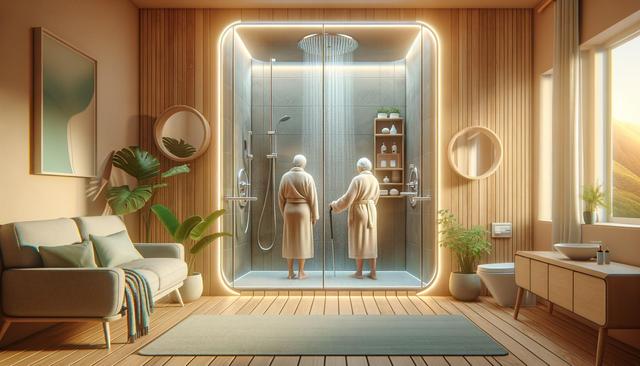Why Walk-In Showers Are Ideal for Seniors
As mobility needs change with age, traditional bathtubs and high-threshold showers can become difficult and risky to use. Walk-in showers offer a safer, more practical solution for seniors. These showers eliminate the need to step over a high ledge, reducing the risk of slips and falls—one of the most common causes of injury among older adults. In addition to safety, walk-in showers are also easier to clean and maintain, which makes them especially attractive for those seeking low-maintenance bathroom options.
Beyond safety, walk-in showers can provide a sense of independence. For seniors who want to remain in their homes longer, having a bathroom designed with accessibility in mind is essential. Features like handheld showerheads, built-in seating, and slip-resistant floors contribute to a more comfortable and self-sufficient daily routine.
Key Features to Consider in a Walk-In Shower
When choosing or designing a walk-in shower for seniors, several important features should be considered to enhance both safety and usability. Here are some of the most valuable components to look for:
- Low or no threshold entry to reduce tripping hazards
- Non-slip flooring
- Grab bars strategically placed for support
- Fold-down or built-in seating
- Handheld showerheads for better control
- Shatterproof glass or curtains for added safety
These elements work together to create a space that not only minimizes risk but also increases comfort and convenience. Installing a walk-in shower with these features can be a proactive step in adapting a home for aging in place.
Design Trends for 2025
As we look toward 2025, walk-in shower trends are evolving to combine functionality with modern aesthetics. Seniors no longer have to choose between safety and style. Here are some emerging trends to watch:
- Curbless designs that create a seamless transition between bathroom spaces
- Textured tiles for better grip and visual appeal
- Warm, neutral color palettes for a calming atmosphere
- Integrated LED lighting for improved visibility
- Smart technology integration, such as digital temperature controls
These trends reflect a broader shift toward universal design—bathrooms that are accessible to everyone, regardless of age or mobility, while still offering a contemporary and elegant look. Innovation in materials and design is allowing homeowners to create bathrooms that are both safe and visually pleasing.
Installation and Professional Planning
Installing a walk-in shower often requires more than just replacing a traditional tub. Proper planning and professional installation are crucial. A well-executed project begins with an assessment of the existing space and the specific needs of the senior who will be using the shower. Working with experienced contractors who understand accessibility requirements can make a significant difference in the final outcome.
Key considerations during installation include:
- Proper drainage to prevent water pooling
- Reinforced walls for secure grab bar placement
- Slip-resistant flooring materials
- Lighting and ventilation adjustments
In some cases, financial assistance or grants may be available for home modifications aimed at improving senior living conditions. It’s worth exploring local or national programs that support aging-in-place renovations.
Maintenance and Long-Term Benefits
Once installed, walk-in showers require relatively low maintenance compared to traditional tubs. Smooth surfaces and fewer crevices mean less time scrubbing and a decreased risk of mold or mildew buildup. Regular cleaning with gentle, non-abrasive products helps maintain the integrity of the materials and ensures continued safety.
In the long run, investing in a walk-in shower can provide lasting value. Not only does it enhance daily comfort and safety, but it may also increase the overall value of the home. For those considering selling in the future, a modern, accessible bathroom can be a strong selling point, appealing to a broader demographic of potential buyers.


